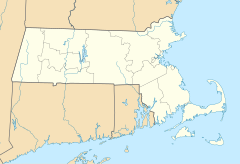Bridgewater State Hospital
| Location | Bridgewater, Massachusetts |
|---|---|
| Coordinates | 41°56′48″N 70°57′08″W / 41.94667°N 70.95222°WCoordinates: 41°56′48″N 70°57′08″W / 41.94667°N 70.95222°W |
| Status | Operational |
| Security class | Level 4 (Medium) |
| Capacity |
227 (Houses 309) Overcrowding rate: 137% |
| Opened | 1855 |
| Managed by | Massachusetts Department of Correction |
| Director | Superintendent Daniel Calis, Jr. |
227 (Houses 309)
Bridgewater State Hospital, located in southeastern Massachusetts, is a state facility housing the criminally insane and those whose sanity is being evaluated for the criminal justice system. It was established in 1855 as an almshouse. It was then used as a workhouse for inmates with short sentences who worked the surrounding farmland. It was later rebuilt in the 1880s and again in 1974. Bridgewater State Hospital currently houses 309 inmates all of whom are adult males. The facility was the subject of the 1967 documentary Titicut Follies. Bridgewater State Hospital falls under the jurisdiction of the Massachusetts Department of Correction.
By the 1970s the campus of the Massachusetts Correctional Institution at Bridgewater (MCIB) housed four separate facilities: The State Hospital for the Criminally Insane, the Treatment Center for Sexually Dangerous Persons, a center for alcoholics, and a minimum security prison.
In 1968 there were hearings conducted after a study showed that there were 30 inmates committed to the state hospital illegally. Most of the prisoners stayed at Bridgewater because they did not have the legal skills or money available to help their claim. Many of the prisoners' terms had long expired. An example of this was a patient named Charles who was sentenced to Bridgewater in 1910 for breaking and entering. The maximum time for this felony was two years, and he still remained in the prison after 1967. Furthermore, in later news, it was found that the number of inmates at Bridgewater grew to 500. Many felt that society was not doing its job in distinguishing men that needed regular prison rehabilitation and psychiatric help. There needed to be changes in what constitutes a person to be sent to a mental hospital. Also among the changes that needed to be implemented were the confidentially between the inmates and the doctors as well as having a standard by which a person is considered mentally insane.
In 1967 a legislative committee investigated allegations of "cruel, inhuman, and barbarous treatment". There were witnesses who were able to describe problems with the water and sewage systems, insufficient medical, kitchen, and recreational facilities. As a result, in 1972 John Boone, the Massachusetts Commissioner of Corrections, closed the segregation unit at Bridgewater State Hospital because it required maintenance. Bridgewater's facilities were not suitable for the standard means of health and living. There were 90-year-old cell blocks which did not have any toilets. Boone closed the Departmental Segregation Unit at Bridgewater to hold hearings for the sixteen inmates who had been transferred out of Norfolk.
...
Wikipedia

